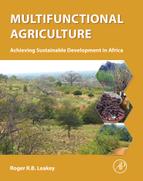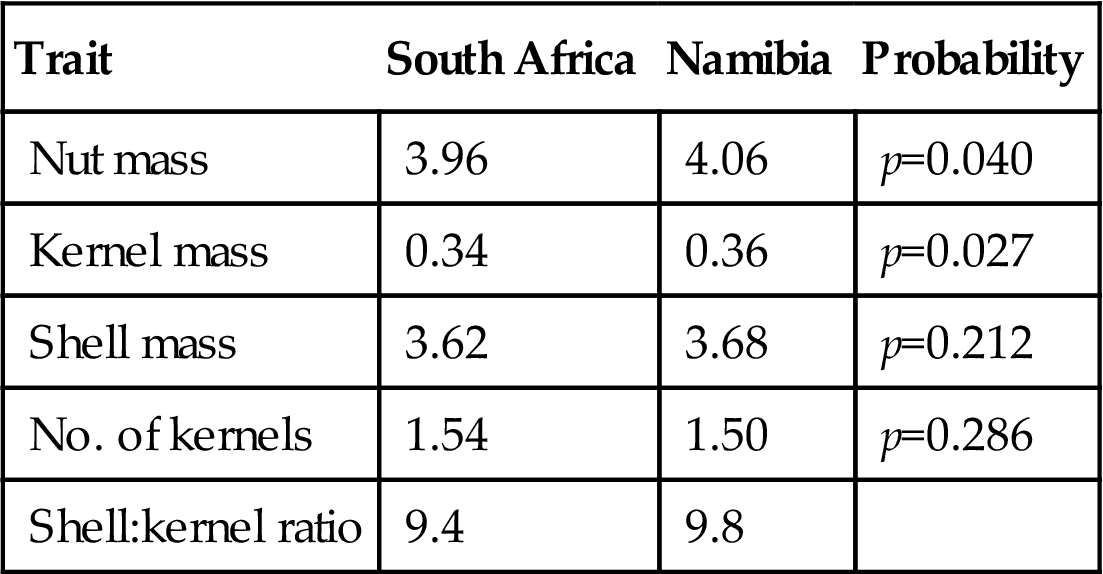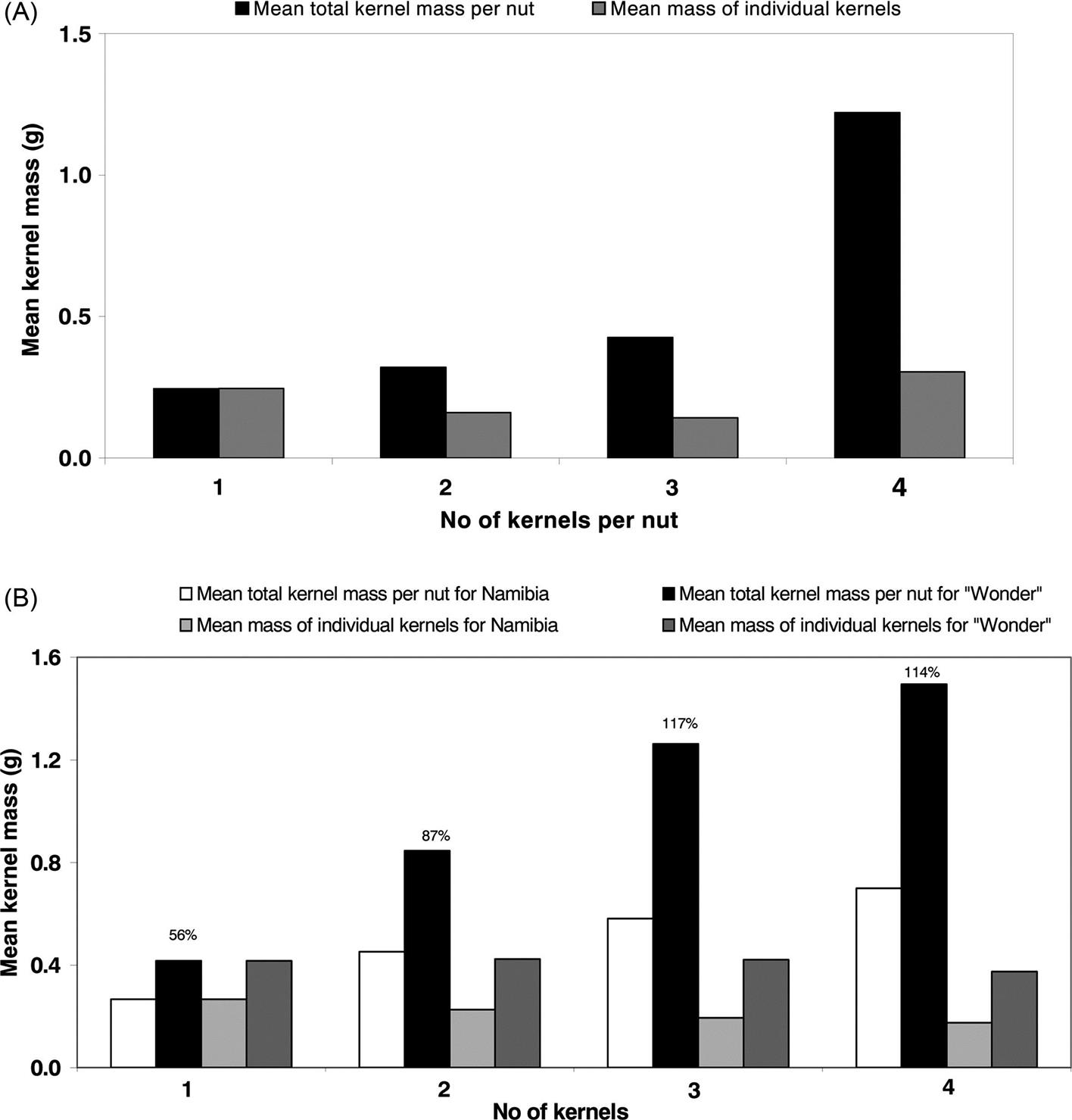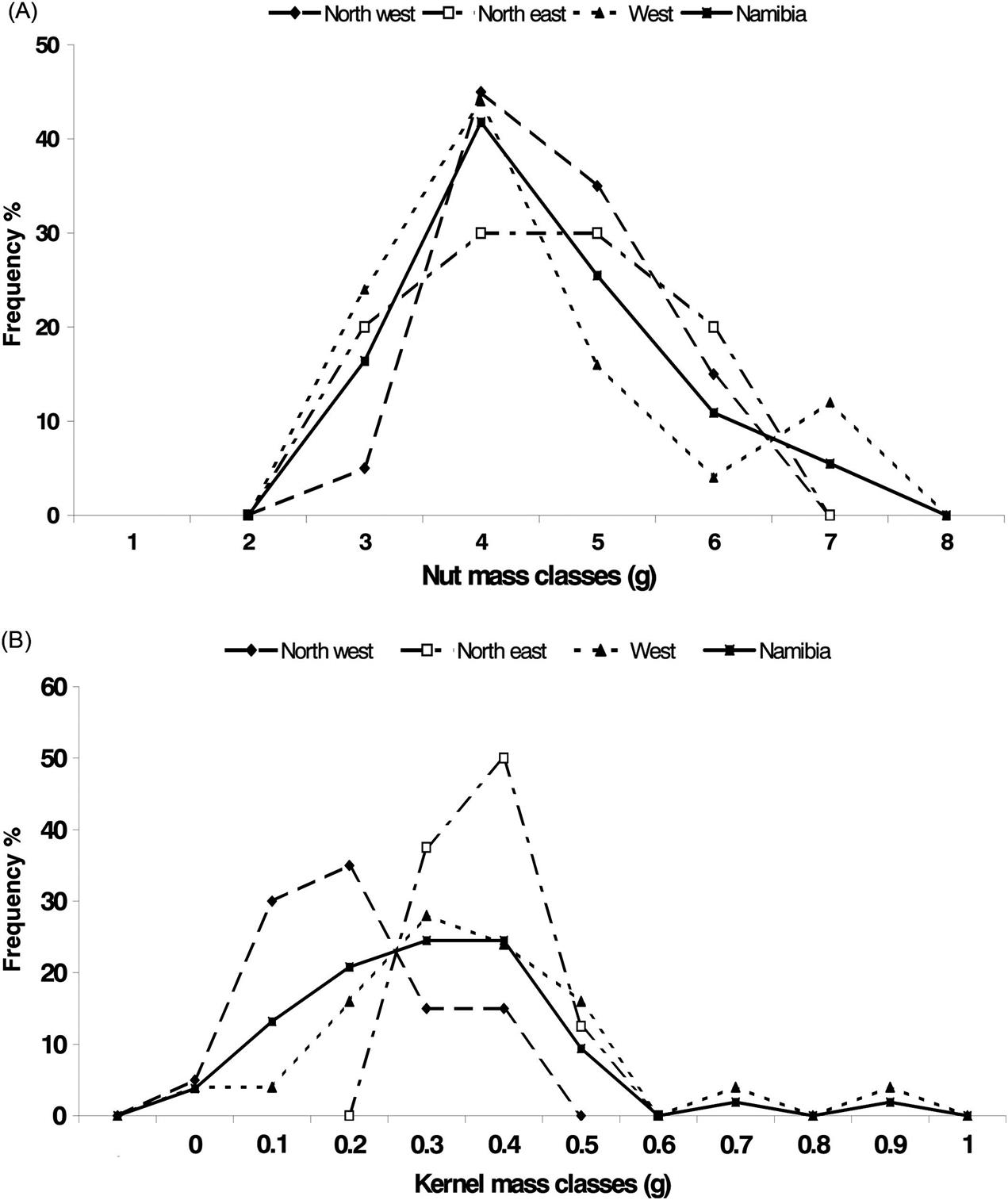Domestication Potential of Marula (Sclerocarya birrea subsp. caffra) in South Africa and Namibia: 2. Phenotypic Variation in Nut and Kernel Traits
This chapter was previously published in Leakey, R.R.B., Pate, K., Lombard, C., 2005. Agroforestry Systems, 64, 37–49, with permission of Springer
Abstract
As part of a wider study characterizing tree-to-tree variation in fruit traits as a pre-requisite for cultivar development, fruits were collected from each of 63 marula (Sclerocarya birrea) trees in Bushbuckridge, South Africa and from 55 trees from the North Central Region of Namibia. The nuts were removed from the fruit flesh, and the kernels extracted, counted and weighed individually to determine the patterns of dry matter partitioning among the nut components (shell and kernel) of different trees. Mean nut, shell and kernel mass were not significantly different between the two countries. Between sites in South Africa there were highly significant differences in mean nut mass, shell mass, kernel mass and kernel number. In Namibia, there were highly significant differences between geographic areas in mean shell mass, kernel mass and kernel number, but not in nut mass. These differences had considerable impacts on shell:kernel ratios (8.0 – 15.4). In South Africa, mean kernel mass was significantly greater in fruits from farmers’ fields (0.42g) than from communal land (0.30g) or natural woodland (0.32g). Within all sites, in both South Africa and Namibia, there was highly significant and continuous variation between individual trees in nut mass (South Africa = 2.3 – 7.1g; Namibia = 2.7 – 6.4g) and kernel mass (South Africa = 0.09 – 0.55g; Namibia = 0.01 – 0.92g). The small and valuable kernels constitute a small part of the nut (Namibia = 6.1 – 11.1%; South Africa = 7.6 – 10.7%). There can be 4 kernels per nut, but even within the fruits of the same tree, kernel number can vary between 0-4, suggesting variation in pollination success, in addition to genetic variation. The nuts and kernels of the Namibian trees were compared with the fruits from one superior tree (‘Namibian Wonder’: nuts = 10.9g; kernels = 1.1g). Oil content (%) and oil yield (g/fruit) also differed significantly between trees (44.7 – 72.3% and 8.0 – 53.0 g/fruit). The percentage frequency distribution of kernel mass was skewed from trees in farmers’ fields in South Africa and in some sites in Namibia, suggesting a level of anthropogenic selection. It is concluded that there is great potential for the development of cultivars for kernel traits, but there is also a need to determine how to increase the proportion of nuts with four kernels, perhaps through improved pollination success.
Keywords
Agroforestry; cultivar development; domestication; indigenous fruits; intraspecific variation; kernel oil; Marula; Sclerocarya birrea; nuts; tree improvement
Summary
As part of a wider study characterizing tree-to-tree variation in fruit traits as a pre-requisite for cultivar development, fruits were collected from each of 63 marula (Sclerocarya birrea) trees in Bushbuckridge, South Africa and from 55 trees from the North Central Region of Namibia. The nuts were removed from the fruit flesh, and the kernels extracted, counted and weighed individually to determine the patterns of dry matter partitioning among the nut components (shell and kernel) of different trees. Mean nut, shell and kernel mass were not significantly different between the two countries. Between sites in South Africa there were highly significant differences in mean nut mass, shell mass, kernel mass and kernel number. In Namibia, there were highly significant differences between geographic areas in mean shell mass, kernel mass and kernel number, but not in nut mass. These differences had considerable impacts on shell:kernel ratios (8.0 – 15.4). In South Africa, mean kernel mass was significantly greater in fruits from farmers’ fields (0.42g) than from communal land (0.30g) or natural woodland (0.32g). Within all sites, in both South Africa and Namibia, there was highly significant and continuous variation between individual trees in nut mass (South Africa = 2.3 − 7.1g; Namibia = 2.7−6.4g) and kernel mass (South Africa = 0.09 – 0.55g; Namibia = 0.01 – 0.92g). The small and valuable kernels constitute a small part of the nut (Namibia = 6.1 – 11.1%; South Africa = 7.6 – 10.7%). There can be 4 kernels per nut, but even within the fruits of the same tree, kernel number can vary between 0-4, suggesting variation in pollination success, in addition to genetic variation. The nuts and kernels of the Namibian trees were compared with the fruits from one superior tree (‘Namibian Wonder’: nuts = 10.9g; kernels = 1.1g). Oil content (%) and oil yield (g/fruit) also differed significantly between trees (44.7 – 72.3% and 8.0 – 53.0 g/fruit). The percentage frequency distribution of kernel mass was skewed from trees in farmers’ fields in South Africa and in some sites in Namibia, suggesting a level of anthropogenic selection. It is concluded that there is great potential for the development of cultivars for kernel traits, but there is also a need to determine how to increase the proportion of nuts with four kernels, perhaps through improved pollination success.
Introduction
Sclerocarya birrea (A. Rich.) Hochst. subsp. caffra (Sond.) Kokwaro is one of the traditionally important indigenous fruits of southern Africa and is now gaining commercial importance (Shackleton et al., 2002b; Wynberg et al., 2002). A previous paper in this series (Leakey et al., 2005b) has indicated its growing importance as indicated by a number of domestication initiatives in South Africa, Botswana, and in Israel. More recently, the World Agroforestry Center (ICRAF), has also initiated germplasm collection and field trials, as part of its international agroforestry tree domestication program (Leakey and Simons, 1998; Simons and Leakey, 2004).
Initiatives in four regions of Africa are developing techniques and strategies for the domestication and commercialization of trees producing agroforestry tree products (AFTPs) for integration into farmland (Simons and Leakey, 2004). This is seen as an approach to poverty alleviation (Leakey and Simons, 1998; Poulton and Poole, 2001) and the environmental rehabilitation of degraded farmland (Leakey, 1999b; Leakey, 2001a,b). The present study, as part of a resource inventory, quantifies the phenotypic variation in fruit, nut and kernel traits in marula, within the framework of a broader project examining the benefits and opportunities for domesticating and commercializing the fruits and kernel oil of marula in South Africa and Namibia (Sullivan et al., 2003). Chemical analysis of fruits and kernels has indicated the potential of marula nutritionally, and as a source of high quality oil, rich in tocopherol (Burger et al., 1987; Leakey, 1999a). Recent collections of marula fruits and nuts from individual trees in Makueni district of Kenya have been analyzed for a wide range of nutritional compounds and minerals, and the kernels were rich (56–64%) in oils (Thiong’o et al., 2002). Kernels are traditionally used extensively in some areas in southern Africa (e.g., Inhambane, Mozambique; Owambo, Namibia; KwaZulu-Natal, South Africa), but little used in other areas (e.g., Kavango, Namibia; Northern Province, South Africa) as a nutritious food, a meat preservative and as a skin moisturizing agent (Shackleton et al., 2002b; Wynberg et al., 2002). The oil is also starting to become important in the cosmetics industry (Wynberg et al., 2002).
Methods and Materials
As already reported for a study of marula fruit characterization, ripe and unblemished fruits were collected from beneath the crown of marula trees in villages in Limpopo Province, South Africa (Bushbuckridge) and Namibia (North Central Region), in 2002 (see details in Leakey et al., 2005b). Fruits from each tree were separately bagged and labeled for use in the study of fruit characteristics (Leakey et al., 2005b) and for the present study. As soon as possible (usually 2–3 days later), the nuts were soaked and scrubbed to remove the flesh before being set in the sun to dry for about 10 hours. When dry, the nuts were weighed and numbered still in the same order as for the study of fruit traits (Leakey et al., 2005b), so that their identity was maintained for subsequent cracking and kernel removal. The kernels were then weighed using a laboratory (0.001 g) balance (Mettler Toledo PB 3002) and packaged for later oil extraction. Shell mass was derived by difference (Nut–kernel=shell).
Additional samples were collected (see Leakey et al., 2005b for details) from the Mhala Development Center (MDC), in Bushbuckridge, South Africa, and from a superior tree (identified here as “Namibian Wonder”).
SPSS 10.0 for Windows was used for the Analysis of Variance, Duncan’s Multiple Range tests, and tests for skewness and kurtosis.
Oil extraction from the South African and Namibian kernels was done by Analytical Laboratory Services in Windhoek using a petroleum ether extract, according to the Deutsche Einheitsmethoden zur Untersuchung von Fetten, Fettprodukten, Tensiden und Verwandten Stoffen (Method code=DGF 8-15 (B7)) method.
Results
Variation Between Sites
Comparison of Mean Values Between South Africa and Namibia
Mean nut, shell, and kernel mass were not significantly different between the two countries (Table 23.1).
Comparison of Mean Values Between Sites in South Africa
There were highly significant differences in mean nut, shell, and kernel mass, as well as kernel number, between sites in South Africa (Table 23.2). Fruits from Allandale were found to be the largest. The trees from Acornhoek Road were located in both farmers’ fields and communal land, while those from Allandale and Green Valley were only in farmers’ fields. Trees from Andover and Wits Rural Facility were in natural woodland. An analysis by land use follows.
Table 23.2
Comparison of Marula (Sclerocarya birrea) nut traits across South African sites.
| Trait | Site | Probability | |||
| Acornhoek road | Andover and Wits Rural Facility | Allandale | Green Valley | ||
| Nut mass | 3.8 b | 4.2 a | 4.2 a | 3.6 b | p≤0.001 |
| Kernel mass | 0.31 c | 0.32 c | 0.45 a | 0.38 b | p≤0.001 |
| Shell mass | 3.5 b | 3.9 a | 3.7 a | 3.2 c | p≤0.001 |
| No. of kernels | 1.4 b | 1.4 b | 1.8 a | 1.8 a | p≤0.001 |
| Shell:kernel ratio | 11.3 | 12.2 | 8.2 | 8.4 | |

Comparison of Mean Values Between Land Uses in South Africa
Mean kernel mass was significantly greater in fruits from farmers’ fields than from communal land or natural woodland in South Africa (Table 23.3). The commercially undesirable trait of a large shell mass was also significantly greater in fruits from farmers’ fields than in fruits from communal land, although not significantly different from those from natural woodland.
Table 23.3
Comparison of Marula (Sclerocarya birrea) nut traits across land use systems in South Africa.
| Trait | Site | Probability | ||
| Farmers’ fields | Communal land | Natural woodland | ||
| Nut mass | 4.18 a | 3.68 b | 4.20 a | p≤0.001 |
| Kernel mass | 0.42 a | 0.30 b | 0.32 b | p≤0.001 |
| Shell mass | 3.78 a | 3.39 b | 3.87 a | p≤0.001 |
| No of kernels | 1.81 a | 1.40 b | 1.44 b | p≤0.001 |
| Shell:kernel ratio | 9.0 | 11.3 | 12.1 | |
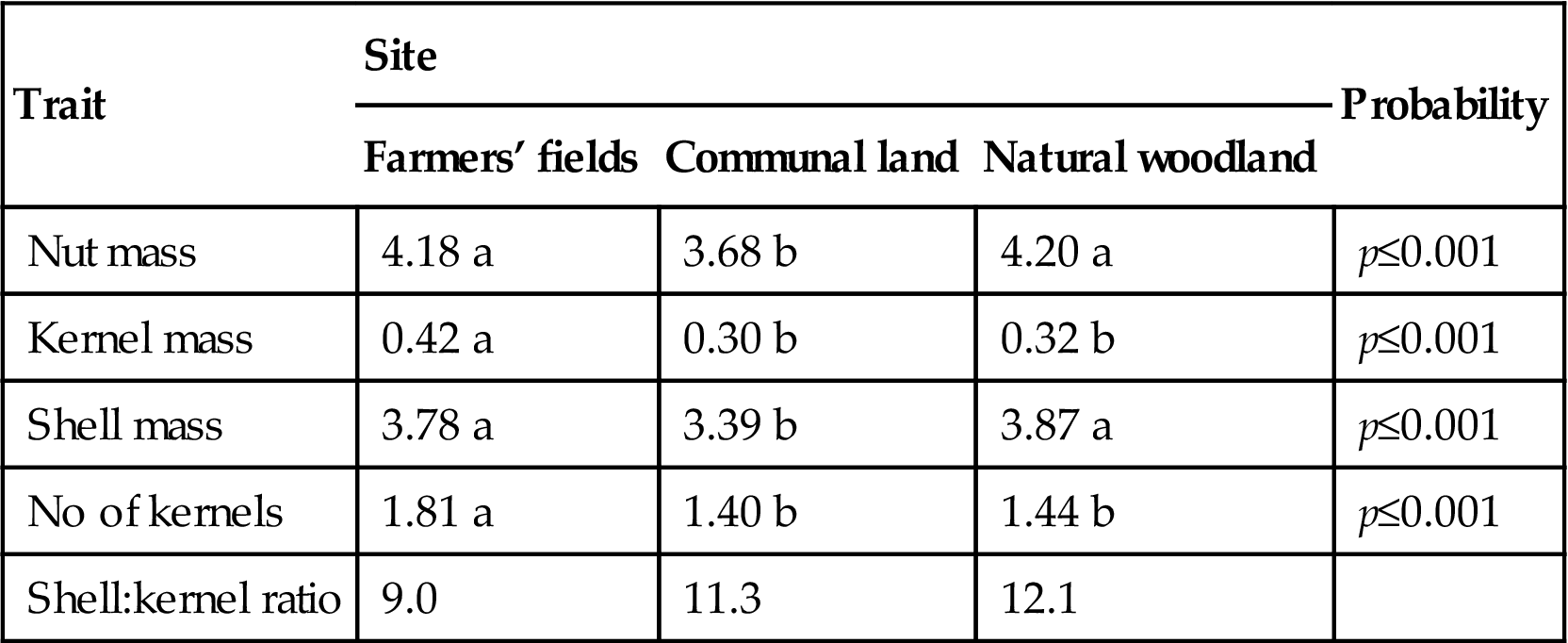
Comparison of Mean Values Between Sites in Namibia
There were significant differences in mean shell and kernel mass between areas in Namibia, but not in nut mass (Table 23.4).
Table 23.4
Comparison of Marula (Sclerocarya birrea) nut traits across Namibian sites.
| Trait | Site | Probability | ||
| Northwest | Northeast | West | ||
| Nut mass | 4.11 a | 4.02 a | 4.04 a | p=0.666 |
| Kernel mass | 0.25 c | 0.32 b | 0.45 a | p≤0.001 |
| Shell mass | 3.86 a | 3.55 b | 3.59 b | p=0.002 |
| No. of kernels | 1.21 b | 1.68 a | 1.68 a | p≤0.001 |
| Shell:kernel ratio | 15.4 | 11.1 | 8.0 | |
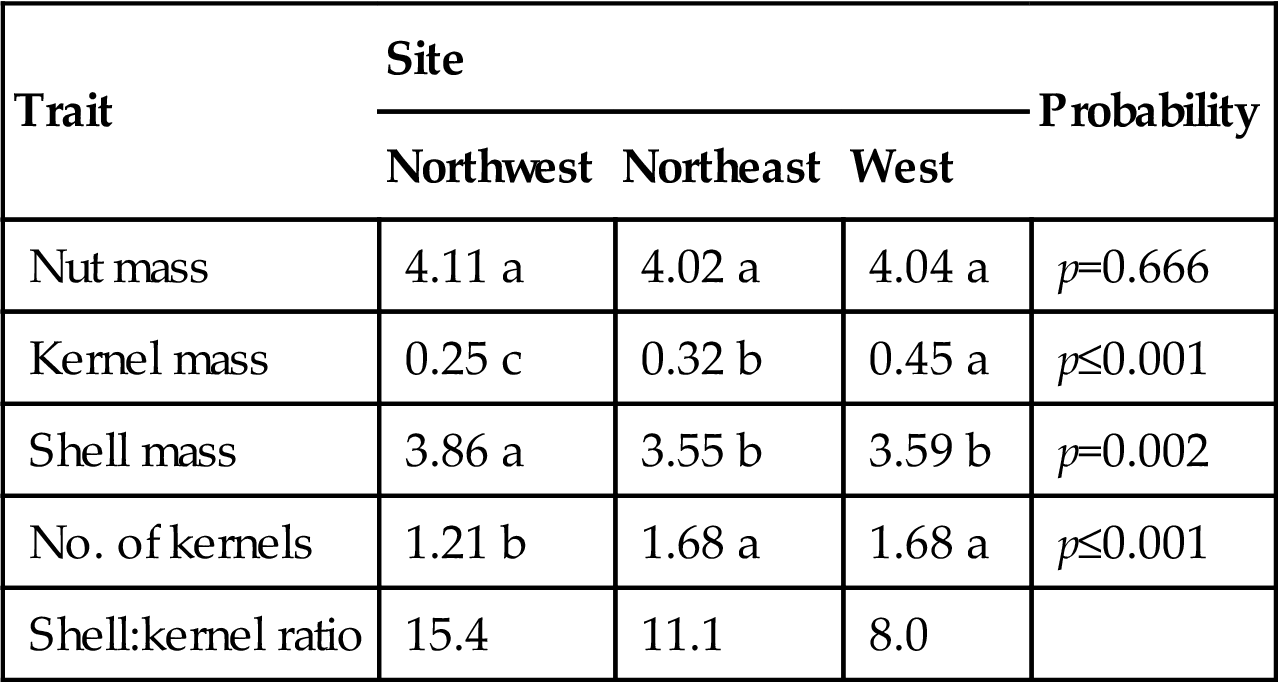
Variation Within Sites
Within all sites, in both South Africa and Namibia, there was highly significant variation between individual trees in the morphological traits of nuts and kernels that were measured.
Nut and Kernel Mass
Tree-to-tree variation in nut mass was statistically significant within all land uses in South Africa (Fig. 23.1A) and within all sites in South Africa and Namibia (Fig. 23.1A and B). Fig. 23.1A and B present nut mass data in the order of decreasing fruit mass, so indicating a weak relationship with fruit mass. The nuts of marula are mostly composed of shell, with the important kernels making up only 3.5–14.8% of the mass in South Africa and 2.8–16.0% in Namibia. Mean kernel mass per nut is the sum of the mass of all individual kernels in the nut, and while there is continuous variation in mean kernel mass per nut, this is not matched by the number of kernels per nut (Fig. 23.2A and B). The mean kernel mass of “Namibian Wonder” was more than twice that of the mean kernel mass per nut of most other trees. However, the shell mass:kernel mass ratio was similar to that of trees from the West district, but was less than that of trees from the northeast and northwest (Table 23.4). In South Africa, the nut mass:kernel mass ratio was lowest in farmers’ fields and greatest in the natural woodland (Table 23.3).
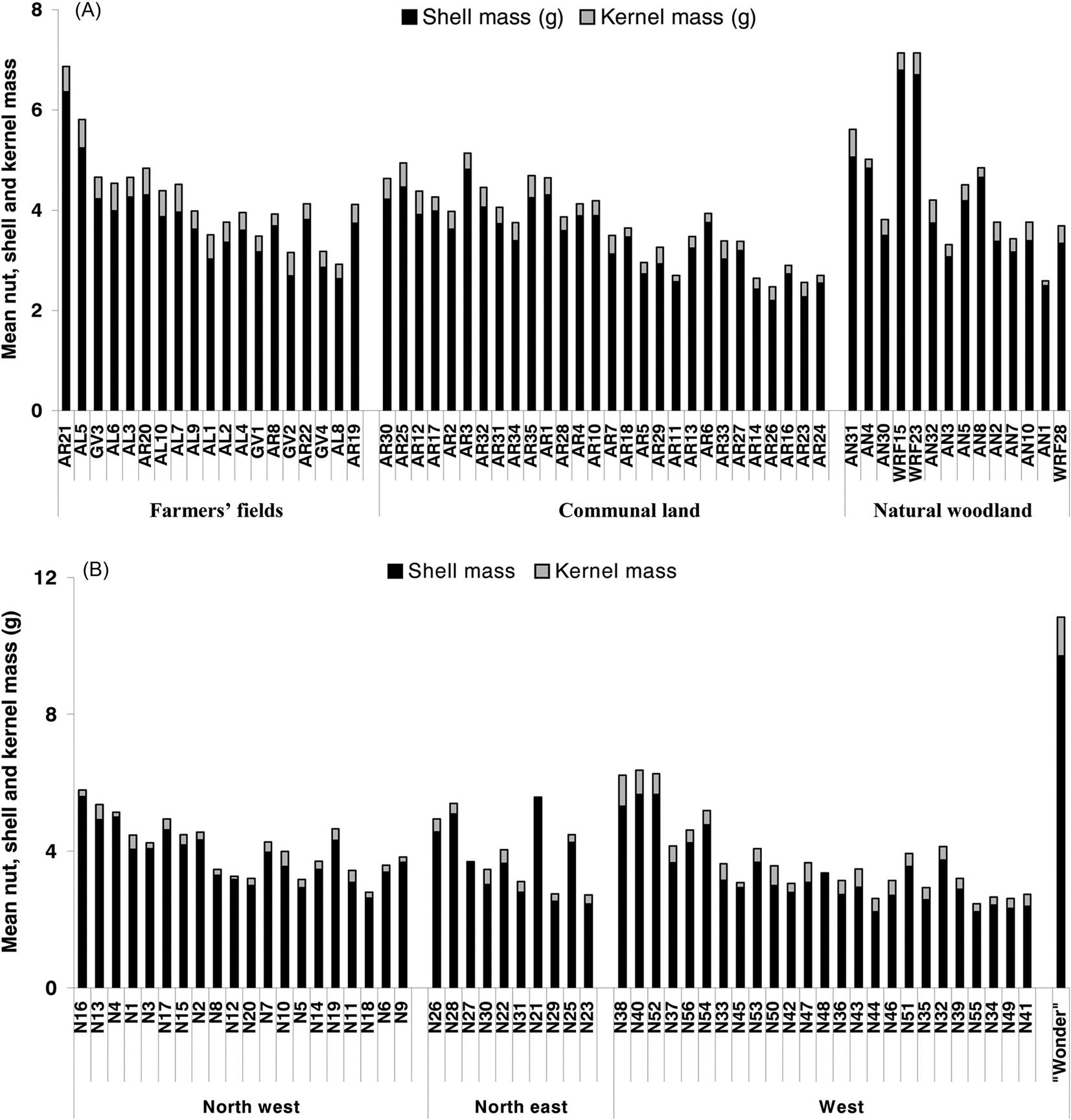
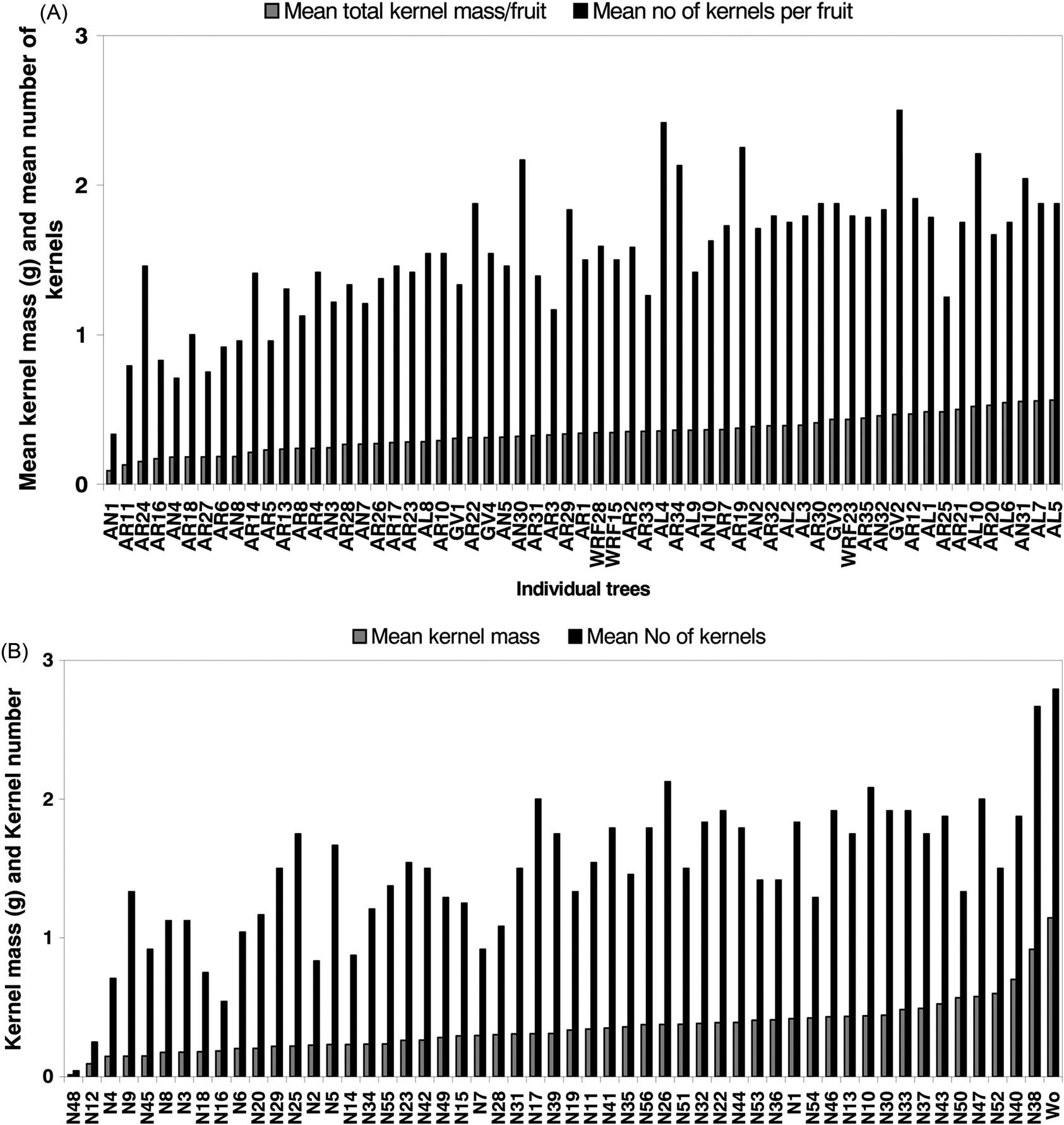
Number of Kernels
There was significant variation between trees in the mean number of kernels per nut (Fig. 23.2A and B). Kernel number per nut also varied within individual tree fruit samples from 0 to 4 kernels per fruit (Fig. 23.3A and B). Nuts with 2–3 kernels were the most common. In both South African and Namibian fruits the mean mass of individual kernels declined, the greater the number of kernels per nut (Fig. 23.3A and B). In contrast, the mean mass of quadruple kernels in South African trees was greater than for other groups, but the sample size was n=2, and consequently can be ignored. In “Namibian Wonder,” the mean mass of individual kernels was constant, regardless of the number of kernels per nut (Fig. 23.3B).
Oil Content
The percentage oil content of both South African and Namibian kernels was not significantly different between land uses or site (South African range=44.7–72.3%; Namibian range=50.2–63.8%). The oil content of “Namibian Wonder” kernels was not dissimilar to that of other trees.
In South Africa, the oil yield per fruit (% oil content × kernel mass) was significantly greater in fruits from farmers’ fields (Fig. 23.4A), while in Namibia it was significantly greater in fruits from west district than in those from the northeast (Fig. 23.4B). The oil yield of “Namibian Wonder” was very much greater than from any other tree (Fig. 23.4A and B).
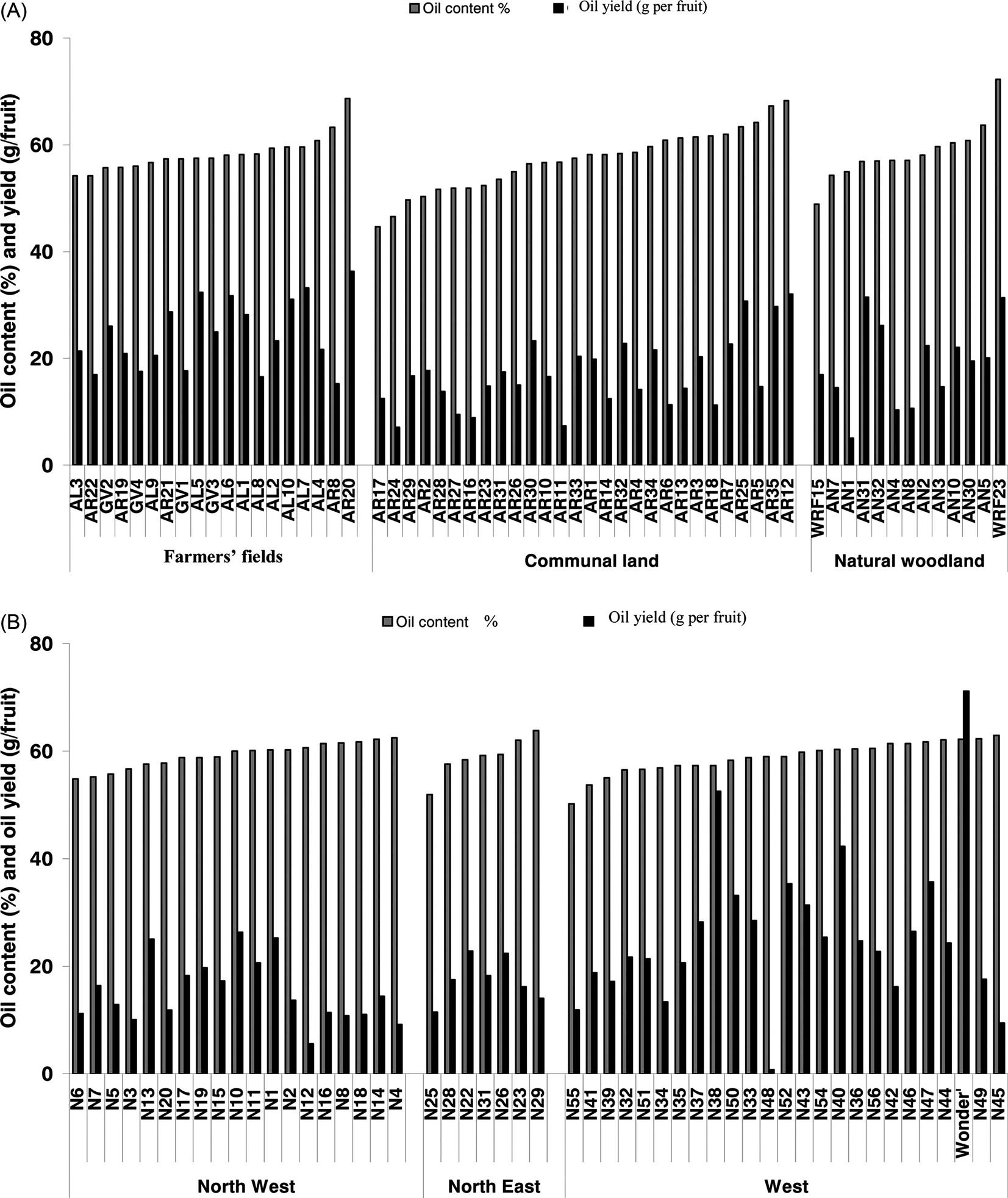
Frequency Distribution
The data for nut and kernel mass of each tree in each site displayed considerable variance about its mean. The frequency distribution of the South African site data sets, and of the overall country mean were close to a normal distribution (Table 23.5). However, when the nut and kernel data for South African trees were aggregated by land use, the frequency distributions for natural woodland remained close to normality (skewness=−0.03 to 0.83), but that for communal lands and farmers’ fields had a tendency toward being positively skewed (Fig. 23.5A and B), the latter also having some bimodality (especially kernel mass). In the Namibian data, the distribution pattern of the same traits had similar distributions (Table 23.6), but the kernel mass in populations from the West had a small number of large kernels (Figs. 23.6A and B).
Table 23.5
Frequency distributions of marula (Sclerocarya birrea) nut trait data from different sites and land uses in South Africa.
| Allandale and Green Valley | Andover and WRF | Acornhoek Rd | ||||||||||
| Mean | SE | Skewness | Kurtosis | Mean | SE | Skewness | Kurtosis | Mean | SE | Skewness | Kurtosis | |
| South Africa | ||||||||||||
| Nut mass | 4.04 | 0.06 | 0.59 | 0.33 | 3.82 | 0.04 | 0.82 | 1.78 | 4.20 | 0.08 | 0.83 | 0.65 |
| Kernel mass | 0.43 | 0.01 | 0.28 | 0.21 | 0.31 | 0.07 | 0.55 | 0.52 | 0.32 | 0.01 | 0.31 | −0.38 |
| Shell mass | 3.60 | 0.05 | 0.28 | 0.50 | 3.53 | 0.04 | 0.79 | 1.87 | 3.88 | 0.07 | 0.93 | 0.79 |
| Kernel No | 0.43 | 0.01 | 0.28 | 0.21 | 1.45 | 0.03 | 0.05 | −0.49 | 1.44 | 0.05 | −0.03 | −0.79 |
| Farmers fields | Communal land | Natural woodland | ||||||||||
| Mean | SE | Skewness | Kurtosis | Mean | SE | Skewness | Kurtosis | Mean | SE | Skewness | Kurtosis | |
| South Africa | ||||||||||||
| Nut mass | 4.18 | 0.05 | 1.10 | 2.16 | 3.68 | 0.04 | 0.41 | 0.37 | 4.20 | 0.07 | 0.83 | 0.65 |
| Kernel mass | 0.42 | 0.01 | 0.41 | 0.26 | 0.30 | 0.01 | 0.42 | 0.17 | 0.32 | 0.01 | 0.31 | −0.38 |
| Shell mass | 3.78 | 0.05 | 1.00 | 2.54 | 3.39 | 0.04 | 0.38 | 0.47 | 3.87 | 0.07 | 0.83 | 0.89 |
| Kernel No | 1.81 | 0.04 | −0.13 | −0.64 | 1.40 | 0.03 | 0.06 | −0.47 | 1.44 | 0.05 | −0.03 | −0.79 |
| Skewness/Kurtosis=0=normality (+skewness=a long tail of high values | − skewness=a long tail of low values | |||||||||||
| +kurtosis=tails longer than normality | − kurtosis=tails shorter than normality) | |||||||||||
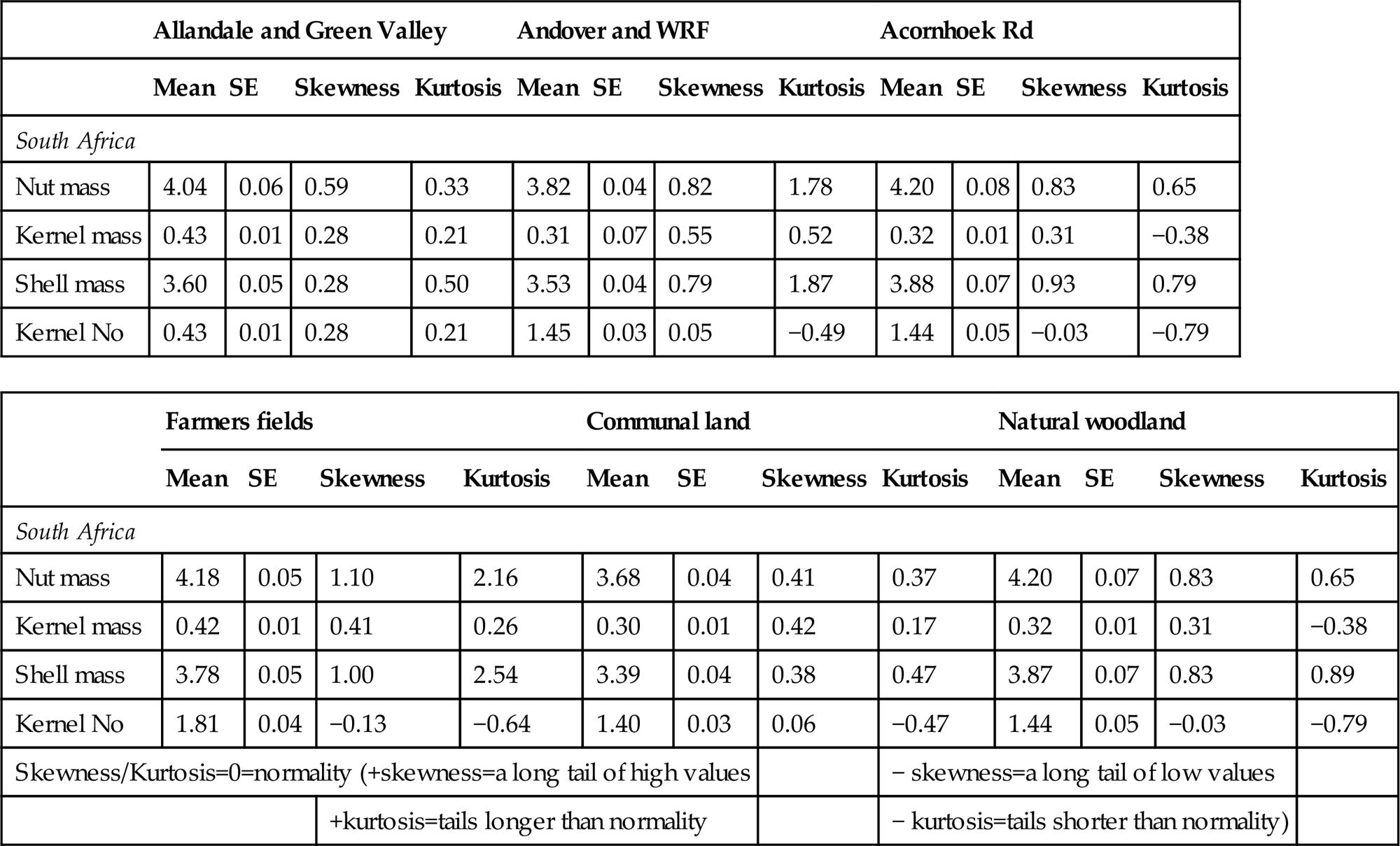
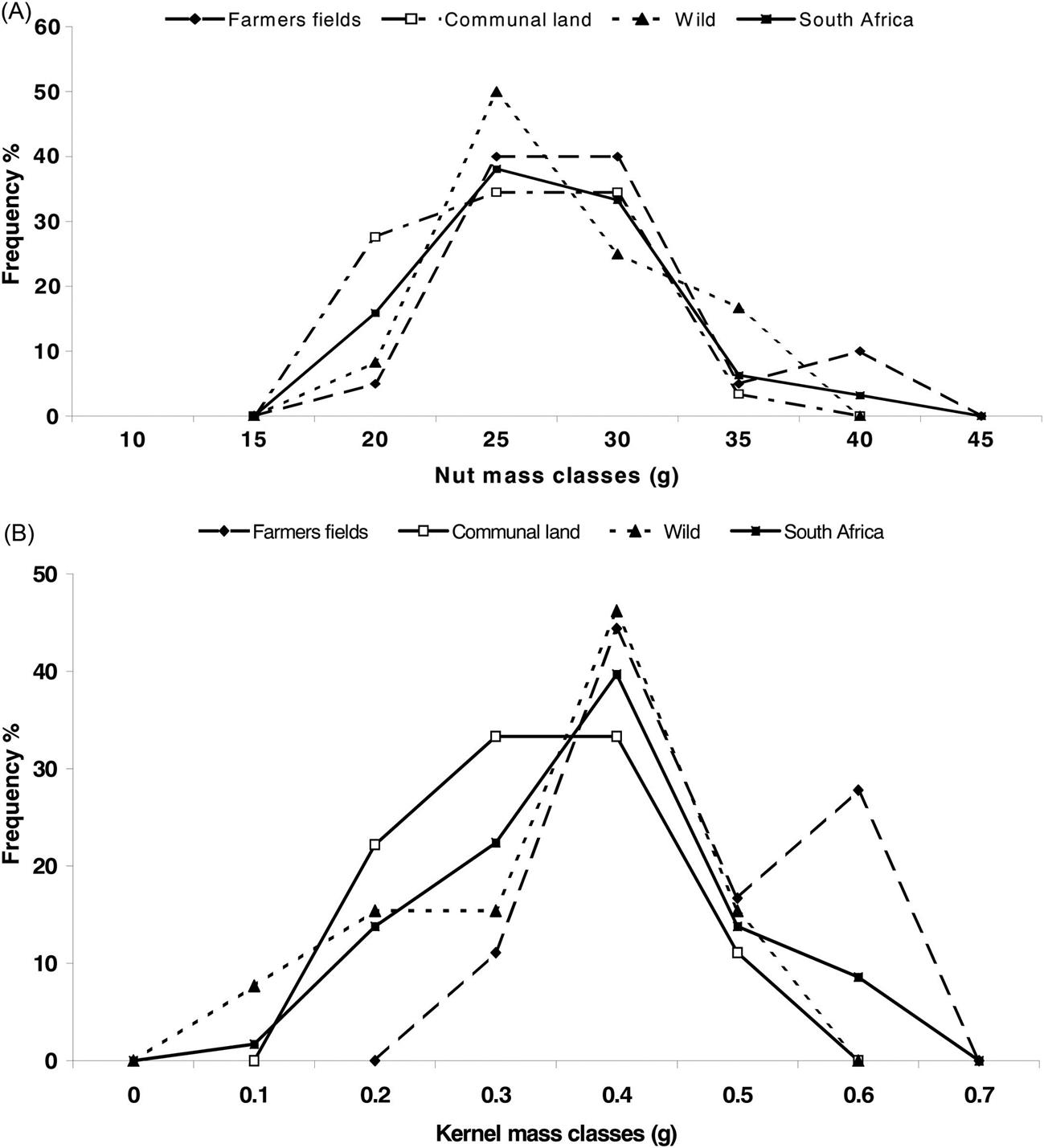
Table 23.6
Frequency distributions of marula (Sclerocarya birrea) nut trait data from different sites and land uses in Namibia, and in South Africa and Namibia together.
| Namibia NE | Namibia NW | Namibia W (excluding Namibian Wonder) | ||||||||||
| Mean | SE | Skewness | Kurtosis | Mean | SE | Skewness | Kurtosis | Mean | SE | Skewness | Kurtosis | |
| Namibia | ||||||||||||
| Nut mass | 4.02 | 0.08 | 0.26 | −0.68 | 4.11 | 0.05 | 0.41 | −0.21 | 3.77 | 0.05 | 1.22 | 1.56 |
| Kernel mass | 0.32 | 0.01 | 0.70 | 0.89 | 0.25 | 0.01 | 0.54 | −0.07 | 0.43 | 0.01 | 0.64 | 0.97 |
| Shell mass | 3.55 | 0.08 | 0.30 | −0.77 | 3.86 | 0.05 | 0.48 | −0.17 | 3.34 | 0.05 | 1.25 | 1.61 |
| Kernel No | 1.68 | 0.05 | 0.30 | −0.59 | 1.21 | 0.04 | 0.26 | −0.64 | 1.63 | 0.03 | −0.17 | 0.09 |
| Skewness/Kurtosis=0=normality (+skewness=a long tail of high values | − skewness=a long tail of low values | |||||||||||
| +kurtosis=tails longer than normality | − kurtosis=tails shorter than normality) | |||||||||||
| South Africa | Namibia | South Africa and Namibia | ||||||||||
| Mean | SE | Skewness | Kurtosis | Mean | SE | Skewness | Kurtosis | Mean | SE | Skewness | Kurtosis | |
| South Africa and Namibia | ||||||||||||
| Nut mass | 3.96 | 0.03 | 0.80 | 1.33 | 4.06 | 0.04 | 1.96 | 6.66 | 4.01 | 0.03 | 1.58 | 5.50 |
| Kernel mass | 0.34 | 0.01 | 0.06 | 0.13 | 0.36 | 0.01 | 1.12 | 2.75 | 0.35 | 0.004 | 0.86 | 1.95 |
| Shell mass | 3.62 | 0.03 | 0.80 | 1.57 | 3.68 | 0.04 | 1.86 | 5.95 | 3.65 | 0.02 | 1.50 | 4.96 |
| Kernel No | 1.54 | 0.02 | −0.02 | −0.61 | 1.50 | 0.02 | −0.02 | −0.26 | 1.52 | 0.02 | −0.02 | −0.46 |
| Skewness/Kurtosis=0=normality (+skewness=a long tail of high values | − skewness=a long tail of low values | |||||||||||
| +kurtosis=tails longer than normality | − kurtosis=tails shorter than normality) | |||||||||||

Discussion
This study quantifies the variation in dry matter partitioning between constituent parts of marula nuts for the first time, and provides good fundamental knowledge about the range of variation in several important traits across geographically separated, as well as environmentally and culturally different sites, as well as across different land uses in South Africa. Unlike the skin, flesh and juice components of marula fruits (Leakey et al., 2005b), the mean nut, shell, and kernel mass were similar in South Africa and Namibia. However, there were differences in kernel mass between all sites and land uses, and differences in nut and shell mass between sites in South Africa and in just shell mass in Namibia, which may reflect differences in the environment, in anthropogenic activity or evolutionary responses to different survival/regeneration pressures.
Evidence from the frequency distribution data of marula nut and kernel mass suggests that as in West African indigenous fruits (Leakey et al., 2004), subsistence farmers have initiated the domestication process. However, in marula, the process does not seem to be well advanced, although several data sets (e.g., nut and kernel mass from the west of Namibia and from trees in farmers’ fields in South Africa) are positively skewed (with a tendency to bimodality). This suggests that farmers, through truncated selection over several generations, have achieved at least the second stage of domestication (Leakey et al., 2005b,c).
The very considerable tree-to-tree variation in nut and kernel characteristics in marula mirror those found in the fruit traits (Leakey et al., 2002) and are consistent with results on nut and kernel traits from other indigenous fruit trees, such as I. gabonensis (Atangana et al., 2001; 2002; Anegbeh et al., 2003). There is, however, one major difference in that I. gabonensis typically has a single kernel within the nut, while marula has up to four kernels per nut. Nevertheless, there was extensive phenotypic variation in dry matter allocation to kernels in both species that is probably genetic in origin. Interestingly, the mean kernel mass of “Namibian Wonder” was more than twice that of the mean kernel mass per nut of most other trees, indicating the potential for individual tree selection for cultivar development.
In marula, the number of kernels per nut greatly affected the total kernel mass per nut/fruit, with an indication that although individual kernel mass is relatively constant, there is a slight reduction in mean kernel mass as the number of kernels per nut increases. This was particularly clear in the Namibian data set (in the South African case only two nuts had four kernels and so the mean is not comparable with that for nuts with one to three kernels). Competition between kernels for assimilates is suggested by this declining mean mass of individual kernels as the number of kernels per nut increases (Fig. 23.3A and B). The constant mean mass of individual kernels in “Namibian Wonder,” regardless of the number of kernels per nut (Fig. 23.3B), indicates that potentially all kernels can have the same mass and that the partitioning of dry matter does not have to be limited by competition. Clearly this would be a desirable trait in any domesticated cultivar. The finding that nuts with single kernels do not have much larger kernels than nuts with more kernels indicates that selection for nuts with a single kernel is not an appropriate strategy.
The varying number of kernels per nut (0–4 kernels per fruit) within individual tree fruit samples indicates that this trait is affected by some environmental factors and is not only a genetic trait. A possible explanation for this variability in kernel number per nut is that not all ovules were successfully pollinated. This is perhaps the result of poor pollinators due to the elimination of nonproductive male trees (Nghitoolwa et al., 2003), excessive distances between trees, or inappropriate weather for pollinator activity. If poor pollination success is the cause of low kernel numbers, then the siting of beehives in male marula trees, or the grafting of male scions into the crowns of female trees, might be advantageous.
Typically kernel mass is about 10% of nut mass (Wynberg et al., 2002), but this study found a range from 2.8–16% between individual trees. Ideally, in developing marula as a nut crop, selection would seek to increase the partitioning of dry matter from shell to kernel, with the additional benefit of perhaps making the nut easier to crack. However, there was little evidence from this study to suggest that shell mass can be greatly reduced, although the shell:kernel ratio of nuts from the west and of “Namibian Wonder” was considerably lower (8.0) than in nuts from the northwest (15.4), offering some hope that shell mass could be reduced to some extent. It is not clear whether this variability in shell:kernel ratio is the result of anthropogenic or environmental selection. The similarity in nut:kernel ratio between “Namibian Wonder” and many other trees, despite its abnormally large fruit is interesting as it demonstrates that “Namibian Wonder” probably represents the upper end of the continuous variation in fruit nut and kernel traits rather than some abnormality in terms of the relative partitioning of dry matter between different components of the nut.
When the marketable product is only a small proportion of the overall production (i.e., represents a low Harvest Index) it is important to maximize its value, or to derive a number of different products from the crop at the same time. In marula, both the fruit pulp and the kernels are marketable, and while the fruits (pulp, juice, shell, and kernel) are fairly small, they can be numerous when grown in farmers’ fields (up to 128,610 fruits have been recorded from a single mature tree; Shackleton et al., 2002a,b). The fruit pulp (skin and juice) is used to make local beer (Shackleton, 2002), and is being marketed as a fruit juice and fermented as an ingredient in Amarula liqueur (Mander et al., 2002). Traditionally kernels are eaten as a highly nutritious food supplement and currently kernel oil is starting to be used in the cosmetics industry. A parallel study (Leakey et al., 2005b) has examined the tree-to-tree variation in fruit traits and found very extensive variation and, thus, the potential for genetic selection. This study has identified equivalent variation in kernel production. Kernels are both a nutritious local food additive, rich in proteins, and a source of oils for a variety of uses from cooking to cosmetics. This study has determined that there is considerable tree-to-tree variation in oil percentage content of kernels (Namibia=50–64%: South Africa=45–72%), which when combined with the variation in kernel mass (0.147–1.144 g) results in large differences in oil yield per fruit (0.01–0.71 g). The superiority of “Namibian Wonder” in oil yield indicates the opportunity for genetic selection, an opportunity which could be further improved by increasing the mean number of kernels per nut through better pollination, as described previously. There is great interest in commercial oil processing in the region, but currently, oil entering the cosmetics industry is a bulk sample of unselected quality. However, there could perhaps be a premium for oil quality, so it is now important to determine whether or not there is tree-to-tree variation in the oil composition and quality.
To meet the evident potential of developing cultivars of marula, it is not yet clear to what extent cultivar development in marula needs to be separately focused on selection for fruit and kernel traits, as in I. gabonensis from West Africa (Leakey et al., 2000; Atangana et al., 2002), or whether selection could be on the basis of the combination of fruit and kernel traits. This will be examined elsewhere (Leakey, 2005).
It is concluded that in addition to the potential for cultivars selected for fruit characteristics, there is equal opportunity to select cultivars for kernel production to meet the needs of markets for nutritious kernels and various oil industries. Cultivar selection would increase uniformity in the product, increase productivity and provide an incentive for farmers to plant marula trees in their farming systems, with concomitant socioeconomic and environmental benefits (Leakey, 2001b).
Acknowledgments
Pierre du Plessis and Sheona Shackleton are gratefully acknowledged for assistance with the field trips in Namibia and South Africa, respectively. This publication is an output from a project partly funded by the United Kingdom Department for International Development (DFID) for the benefits of developing countries. The authors are indebted to DFID for funding this project (Project No R7190 of the Forestry Research Program) and the views expressed here are not necessarily those of DFID.
